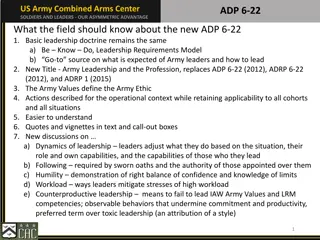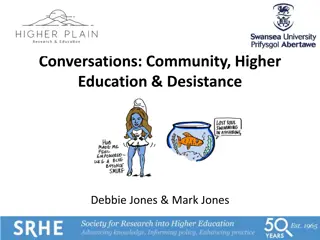Leadership in Higher Education: Insights and Practices
Exploring the unique aspects of leadership in higher education, this presentation delves into the traits of an effective leader, comparisons of leadership practices, and the importance of inspiring a shared vision and challenging the existing processes in academic settings.
Download Presentation

Please find below an Image/Link to download the presentation.
The content on the website is provided AS IS for your information and personal use only. It may not be sold, licensed, or shared on other websites without obtaining consent from the author.If you encounter any issues during the download, it is possible that the publisher has removed the file from their server.
You are allowed to download the files provided on this website for personal or commercial use, subject to the condition that they are used lawfully. All files are the property of their respective owners.
The content on the website is provided AS IS for your information and personal use only. It may not be sold, licensed, or shared on other websites without obtaining consent from the author.
E N D
Presentation Transcript
Leadership Is Higher Education Different? Gerald Pech Acting Dean College of Social Sciences, KIMEP U
Preface Because I am (acting) dean, this is mainly a talk about what a dean as a leader should do Standing on the shoulder of giants
Is Leadership in Higher Education Different? The answer is, of course, . .. not quite but almost . ,
Traits of a Leader? Presence Analytical strength Trustworthiness also decisiveness, effectiveness, persuasiveness, orientation towards goals
Comparison of Effective Leadership Practice (Black, 2015) Five Practices of Exemplary Leadership (Kousez/Posner) Effective University Department Leadership (Bryman) To be the way? Model the Way Establish principles on treating people Establish principles for pursuing goals Set standards of excellence Set interim goals and quick wins Unravel bureaucracy Signpost the way to go Create opportunities for success Acting as a role model and having credibility Being considerate Treating academic staff fairly and with integrity Being trustworthy and having personal integrity
Inspire a Shared Vision Belief that one can make a difference Envision the future with a unique image Enlist others in these dreams Breathe life into the vision Get people to see exciting possibilities ~ Inspire Some Sense Clear sense of direction/strategic vision Preparing department arrangements to facilitate the direction set Communicating well about the direction the department is going
Challenge the Process => Function within the process? Seek opportunities to make changes Innovate to improve the organisation Experiment and take risks Accept mistakes, disappointments and failures as opportunities to learn. Advancing the department s cause with respect to constituencies internal and external to the university and being proactive in doing so Enable others to Act Foster collaboration Build team spirit Actively involve others ~ Enable others to Act Creating a positive and collegial work atmosphere in the department Allowing the opportunity to participate in key decisions/encouraging open communication
Established Processes are Different! Universities defy a strict command-control structure Academic self-governance committees! Designed to protect academic freedom Trying to make HEI more efficient would mean making them less academic hence less credible Universities are supposed to produce diversity!
Leadership in Different Areas What we can learn from different areas of leadership Business Politics The Military emphasis might change according to field but the boundaries are often fluid
the concept of running the state as a private business interest is not new Ludovico III Gonzaga (1412-1478 - by Andrea Mantegna) The comparison is inspired by the Don Alphonso-blog on FAZ.net
Renaissance Thought on Leadership Machiavelli (1513) as seminal treatment of leadership as the art of a statesman of staying in power and increasing his territory Machiavelli emphasizes analytical skills but he does not ignore the need to bring the people on ones side a citizen army is better than mercenaries fear is ok but avoid hate
Military Leadership Military operations are said to share similarity with business operations Xenophon in The Education of Cyrus : Cyrus the Great, King of Persia 559-530 BC Cyrus generosity towards his subjects and his sharing with his lieutenants strengthens their commitment
Academic Leadership Not necessarily what a dean does although some academic credibility helps An academic leader facilitates goal achievement by other academics by their position within research networks finding/defining research fields attracting funding helping others to get published
Co-author Network Goyal et al, JPE 2006
What Makes Leadership in HE Different?
Institutional Differences See above: No command-control structure Academic self-governance designed to protect academic freedom
Integrative Model: INFLUENCE LEADERS- FOLLOWES LEADERSHIP ORGANIZATIONAL OBJECTIVES CHANGE PEOPLE thanks to my colleague Aliya Tankibayeva
What motivates people? Extrinsic motivation Remuneration Fear of dismissal Carrot and stick approach works Intrinsic motivation People are motivated by the work they do they do not need to be pushed but supported
What motivates people In HEI you normally deal with people with high intrinsic motivation And if faculty is tenured the ultimate stick is not available Pay increase is only available through promotion So you need to enable people to develop their careers and this typically serves both them but also the university. strengthening the research culture
What motivates people This low pressure internal situation may be completely reversed if the university operates in high pressure environment typically with strong pressure to publish British example: If you don t publish you end up doing all the teaching So even tenured faculty might find themselves in positions where they are cut off from personal development opportunities
Leadership styles Finding a balance between task and people s needs
Leadership Styles Authoritarian style (Blake/Mouton-defined) emphasizes the task more than the people Clearly a no-go in many academic environments But if there is great external pressure to be productive deans might pass on this pressure So authoritarian style is not infrequent among deans
When can you avoid being authoritarian? Conflicts typically emerge when there is a discrepancy between available resources and demands So dean needs to be sure that he has necessary resources at their disposal.























